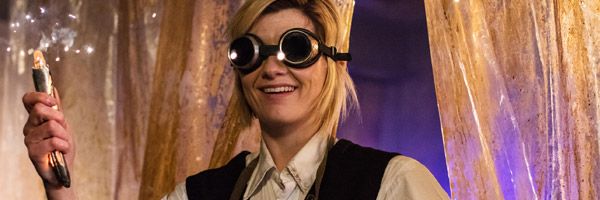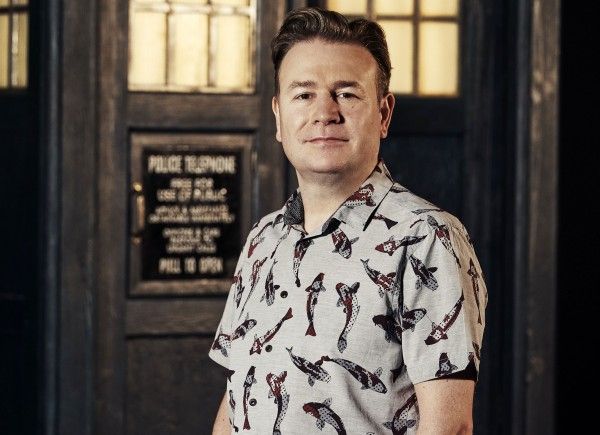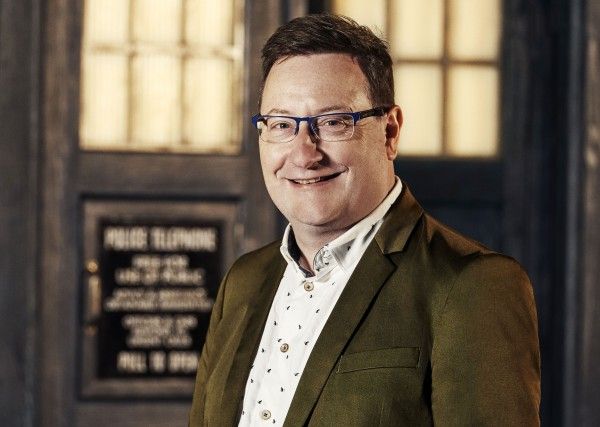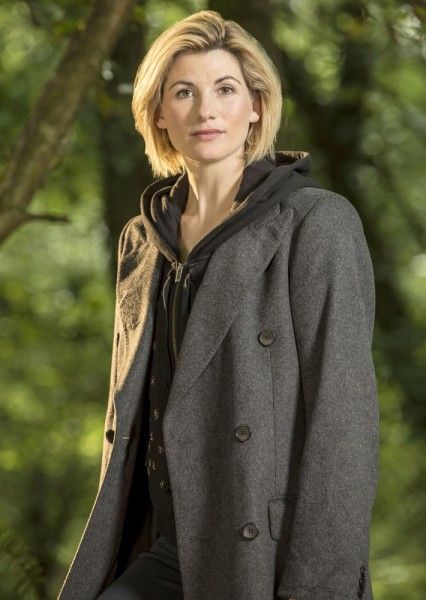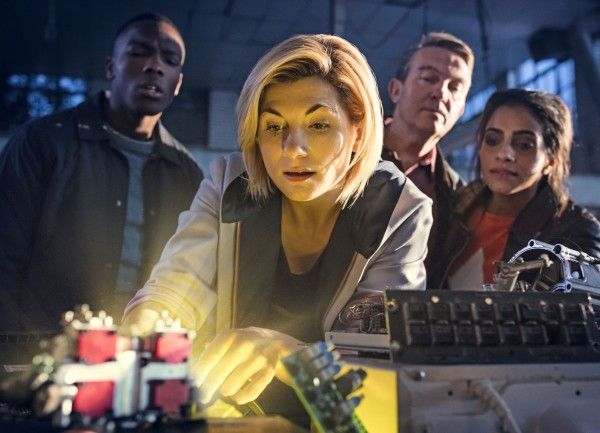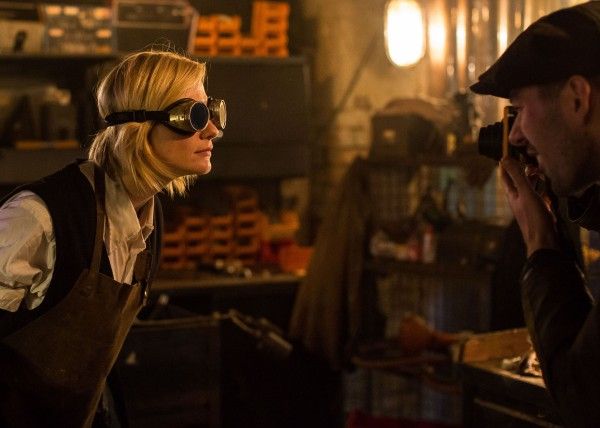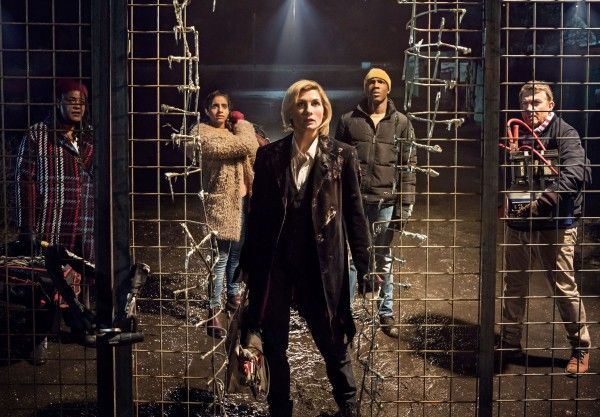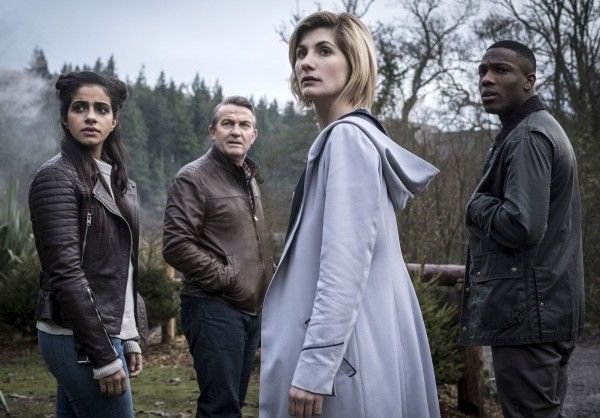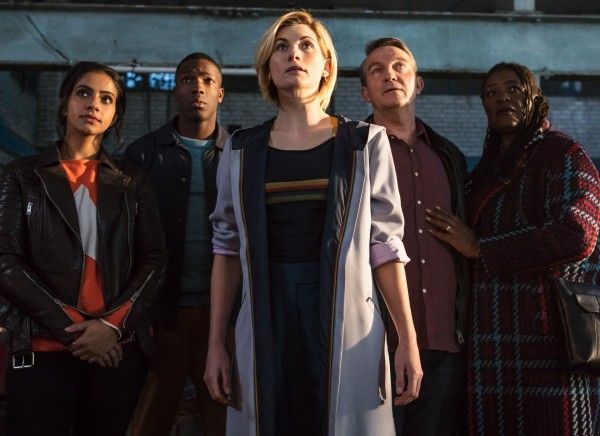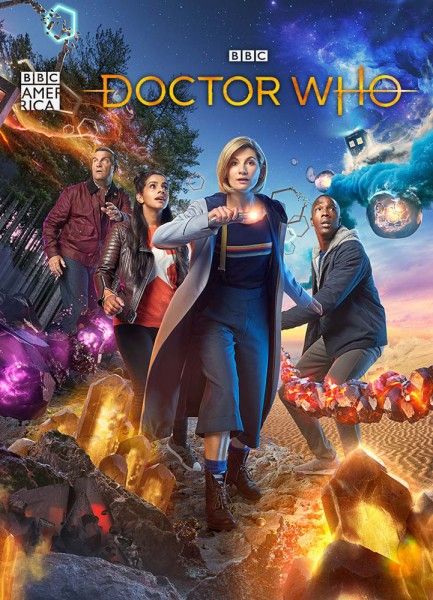It is an all-new and very exciting era of Doctor Who, with new showrunner Chris Chibnall, the groundbreaking debut of Jodie Whittaker as the Doctor, a new team (made up of Tosin Cole, Mandip Gill and Bradley Walsh), new monsters (some of which are sure to give you nightmares) and new adventures traveling through space and time. Packed full of action, humor and emotion, it is the perfect time to tune in, whether you’re a new or long-time fan, and whether you’ve seen every episode, only a handful, or you’re checking it out for the first time.
During this phone interview with Collider, executive producers Chris Chibnall (who wrote the first episode back, “The Woman Who Fell to Earth”) and Matt Strevens talked about the challenges unique to making a series as epic as Doctor Who, the fun of getting to create new monsters, why they chose to do stand-alone episodes this season, finding the look for this Doctor, the point they decided they wanted a female Doctor, and the cool factor of getting to make Doctor Who when you’re a life-long fan. And don’t worry, keeping with the highly secretive Doctor Who tradition, no spoilers were revealed or discussed.
Collider: I very much enjoyed the premiere episode and getting to meet Jodie Whittaker’s Doctor!
MATT STREVENS: Oh, I really appreciate that. Thank you!
You guys are both responsible for quite a bit of great TV in the UK. What are the challenges that are unique to making Doctor Who?
STREVENS: For this particular version of the show, it’s been so wonderful, the way that Steven [Moffat] and Peter [Capaldi] had presented their iteration of the show. It was so distinctive and created such a clear world. Then, when we came in, one of the things we wanted to do was make sure it was Doctor Who, but also bring something fresh and different to it. And so, I think one of the biggest challenges was not to break it. That was my biggest worry. It was like I was carrying around a Waterford crystal, worrying every minute. But also, we wanted to figure out what we could do to make sure it’s as contemporary as can be, with our budget, which is obviously finite and limited. How do we make sure that it fits alongside the wonderful television and film content that is around today? A lot of audiences don’t differentiate any more because they watch all kinds of devices. So, when Chris told me his ambition for the show, the biggest excitement for me was, how do we bring that to life? How do we make it look as contemporary, as special, and as rich as we can? So, the look of the new show was a great technical challenge ‘cause we really wanted that to punch through.
CHRIS CHIBNALL: Having made other shows, the thing with Doctor Who is that you’re doing everything, all at once. Last year, I did Broadchurch, and we did episodes in the same location with the same characters and same sets, for eight hours. That’s hard because you have to build all of the sets, find the locations, do all of the storytelling, and do the edit. With Doctor Who, we have all of that, and then we’ve got monsters and alien planets, and we blow stuff up, and we jump around in space and time. It’s super-sized and super intense. It’s like every television show you’ve ever done, and then there’s a whole other television show on top, and a whole layer of great craftspeople. You’ve gotta be on top of it because we wanted to make sure it sits alongside everything that’s on Netflix, Hulu, Amazon, HBO, the BBC, and everywhere. But the joy of it is working with these craftspeople who are there. There is great joy in watching exceptional talent exercise that talent, whether it’s the cast, the composers, the special effects guys, the people who blow stuff up on set, or the people who make monsters for us. That’s the hugest joy. It’s the most joyous job that I’ve ever had in television. It’s the hardest job, but the most joyous, absolutely.
You’ve talked about how there are many familiar Doctor Who things that could make an appearance in the future, but for now, you’re focused on the new faces and the new monsters. How much fun is it to be able to create and bring a monster to life, and give them a whole backstory and arc on the show?
CHIBNALL: Imagine the best fun you can possibly imagine. It’s really exciting. There’s a number of reasons that it’s exciting. It’s exciting for us, as creators, producers, writers, directors and monster designers. It also gives me a thrill to think of the 8-year-old, the 28-year-old, the 38-year-old, or the 98-year-old, seeing the new monster, for the first time, and getting a thrill or scare. We get to bring a new generation of monsters to a new generation of viewers, and also to people who’ve loved the show for 55 years, 12 years, or 22 years. Doctor Who is such a broad show. It’s got the whole universe to explore. So, when you can create a new monster, and then the monster comes onto set for the first time, or you have a special effects or CGI session, you’re deciding how it sounds, and how it walks or flies or kills people. The thing we’ve often said about Doctor Who, and I’ve talked about this with Steven and Russell [T. Davies], is that Doctor Who is the show that makes everybody feel like an 8-year-old again, in the best possible way. When you’re making monsters, that’s also how you often feel, making them. It’s just joyous.
You guys have said that you’re not going to be telling any ongoing stories this season, except for when it comes to this new team bonding with each other and building their relationship. Was doing only stand-alone episodes this season something you knew that you wanted to do, from the beginning, and was there a specific reason for doing that, for your first season of the series?
CHIBNALL: Yeah, I came in very much wanting to do that. Under Steven, the show had done these really captivating, mesmerizing, intricate series arcs. Steven is just spectacularly good at that, and the pay-offs, over time. He’s the absolute genius of that. But I think whenever you’re bringing in a new Doctor, you have to set it up in a really great way because it’s an entry point for a whole audience. Because the audience of Doctor Who is everyone from eight to 108, life is continually creating new viewers. There are people who were four or five when Peter came in, who weren’t quite old enough to watch it then, but who now are. Also, there are people in their 20s who told their friends, “We’ve been watching Peter Capaldi, and you should tune in now because it’s amazing.” So, we had to make sure that it’s really open to new audiences while also serving fans. On any other TV show, if you said, “The ongoing story is the emotional dynamics of the characters,” that is most TV drama. We’re doing that, as well. It’s a relationship between people, and how they develop in response to the adventures they’re having. That’s a big bit of storytelling that you want to be doing, especially when you’ve got such a great ensemble, that we’re really lucky to have this year. So, with stand-alone stories, you can come in and not need any knowledge. That felt really useful this year. It’s like a series of pilots. If you come in on Episode 5, Episode 7, or Episode 9, you can really access that, but there will be rewards for people who’ve been there since Episode 1, and there will be rewards for people who are long-term fans. There are plenty of little lines and references. So, the short answer is it’s a new Doctor with new access. For anybody who wants to catch up, they can go back and watch all the old stuff, and that’s really cool. I think Doctor Who is the greatest idea television has ever had, and our job is to convince the rest of the world.
Every Doctor has their own look, and Jodie Whittaker’s Doctor definitely does. How long did it take everyone to decide on this look? Did you go through many variations, or did this one happen rather quickly?
STREVENS: Basically, it started with Jodie, herself, who sent a couple of images to Chris and I, when she was auditioning for the part and we’d moved on in that process, whereby she just had this idea of a look. The images were very, very arresting, and really got us excited. And then, when she was offered the part, she went and met with Ray Holman, who’s our brilliant costume designer, and who worked with her before on other shows, including Broadchurch, and they put the costume together. Ray had some ideas, but Jodie very much contributed a huge amount to that. She had to be very comfortable in what it was. So, when we were first presented with something, it was almost fully formed. We didn’t add anything to it, to be quite honest. We were absolutely blown away. It was so instantly iconic, really. The lovely thing about it is that Jodie very much designed it with Ray, and she loves wearing it. We did some photo shoots with her the other day, for the launch in Sheffield in the UK. She hadn’t put the costume on for awhile because we wrapped filming, and the first thing she said to Chris and I, when she walked up was, “I’ve missed putting this on! I love putting this on.” And we just thought that was great because it could have been the other way around. She really loves the look. Initially, I loved it, but the more I see it, the more I see how clever it is. The more it’s used and the more the iterations go around in the graphics and we see the imagery that’s circling around as we’re launching, it just blows me away.
CHIBNALL: Yeah, I think that’s really true. It really is just the genius of Ray Holman, who designed Matt Smith’s costume, which is iconic, in itself, and Jodie. Those two together just nailed it.
Chris, when you signed on as the showrunner for this, did you already know, at that point, that you wanted to cast a woman as the Doctor, and was that something the network was immediately onboard with?
CHIBNALL: When the offer was rumbling around, and I was deciding whether or not to take it, there were all sorts of discussions about, “Well, if I do it, then where is the show going, in the next five years, or whatever?” Part of that was at the point when Peter was still deciding on his future, so it was more of a conversation about when Peter would decide to hang up his coat. We thought, “What would be the next iteration?” And that was a conversation where I said, “For me, it needs to be a female Doctor, at that point, whenever that point arises.” And the network, the BBC, were absolutely like, “Yes.” That was not a long conversation. They were totally on board with it, from the moment I brought it up.
STREVENS: I will say that the BBC have been awesome, on Doctor Who. They’ve looked after it 55 years, and they don’t want it to be a museum piece. That’s the big thing. They’re really an incredibly supportive network. No other network would do this show, this way.
Since both of you are clearly Doctor Who fans yourselves, it must have been quite the experience, the first time you both were on the set for this new season, having a new Doctor and seeing how everything was coming together. What was that experience like, for you guys?
STREVENS: There have been many moments, in this process, that have been surreal, even coming down to designing the new logo for the show, or getting to sign off on the Doctor’s costume. In terms of being on the set, there were two moments. There was the moment when we were on Steven and Peter’s set, with the regeneration. That was an out-of-body experience, seeing her in Peter’s costume and on the TARDIS. Some of the crew that been with the show since Russell bought it back were just spellbound by her, even though she only had one word in that episode. That was emotional, and being on that set was just incredible. And then, the first day of filming for our season, in the middle of night, in the rain, in Wales, in a yard for exterior shots, and with quite difficult and tricky stuff to start with, just standing there by the monitor, Chris and I were very, very emotional. It’s surreal that you’re there, making Doctor Who. It’s one of those things that, as a kid, you might dream about, but it never happens. Although I went to Television Center, where they used to film Doctor Who, on the off chance that I would get to see the set, it was never up when I went there. There were loads of sitcoms there, but the TARDIS was never out. It was my dream to go into the TARDIS. To be on this set is a childhood dream come true. It’s Christmas for me.
CHIBNALL: It’s funny how emotional it is. It’s weird, having made the show and now it’s about to go out, for all of us – Jodie, the script team, the directors, and everyone – it’s a really emotional moment for us. In addition, we got sent the first demo from Segun Akinola, who’s the composer that we brought onto the show this year, of his version of the Doctor Who theme, where he used a lot of the original recordings, samplings and sounds that were created by the BBC Radiophonic Workshop and Delia Derbyshire, one of the great sound pioneers, back in 1963, for the show. He’s used those elements in this new reworking of the theme, that feels very modern and also incredibly classic, as well. When you put the headphones on for the first time, you don’t know what you’re going to get, and that blew me away. I was in tears of happiness and absolute joy. I had goosebumps, listening to that. And then, we also we have a new title sequence this year. There isn’t a title sequence in Episode 1, but there is in Episode 2 and every episode, thereafter. Working on that and seeing that come together was also amazing. Putting all of that together, for the first time, was just a thrill because that’s when it felt like Doctor Who. Suddenly, there was a theme and a title and a logo. All of it is emotional, in different ways. Seeing designs for Jodie’s sonic screwdriver, for the first time, was emotional. With a new Doctor and a new era, there are lot of firsts that you get to do. So, having loved the show and feeling that it’s part of your DNA, and having it feel so ridiculously bound up in my own identity and personal history, to then get to work on it, in any capacity, is a privilege and an honor. Matt said to me the other day, “I really hate when people say that things are humbling,” but working on this show is really humbling because you know that you’ve got a responsibility to everyone who loves it, and we love it as much as those people love it. Our job is to make it new for those people, and for everyone who doesn’t know yet that they love it, but that I hope will. We’re quite emotional about it.
As cool as it is to make any TV show, I would imagine that there’s an extra little added bit of cool when you’re making Doctor Who.
CHIBNALL: Yes, and it comes in at about a million percent, over than any other TV show because of those extra things, like the explosions, the monsters, the CG, the spaceships, the going into historical periods, and the passion, expertise, dedication and hard work of the people that make it. They were already doing amazing work, and they continue to do amazing work. For every fan who loves this show, you are being represented by people on this show who have as much passion and dedication, and who have dedicated every waking hour and some of the hours they should actually be sleeping, to Doctor Who. It is a privilege to be a part of a team who just adores it. To work on something you love is really special, and it feels like a very special time in our lives. What we all really hope is that the audience feel that way when the show goes out, as well. Hopefully the passion that everyone has put into it connects with the audience, and that they feel there is some special stuff.
Doctor Who airs on Sunday nights on BBC America.

